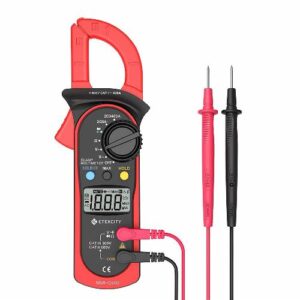
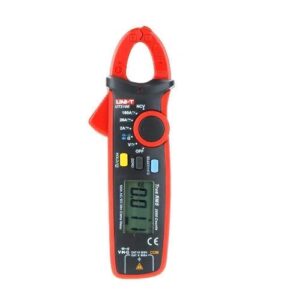
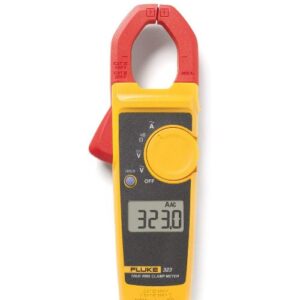
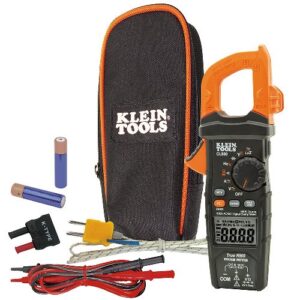
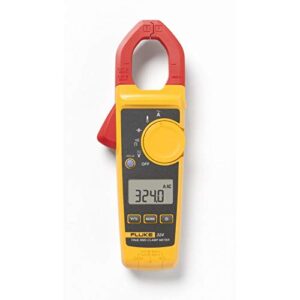
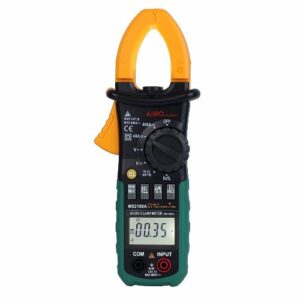
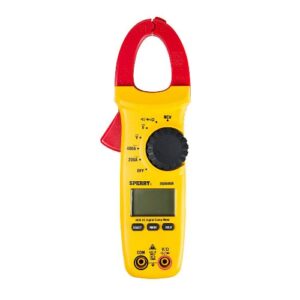
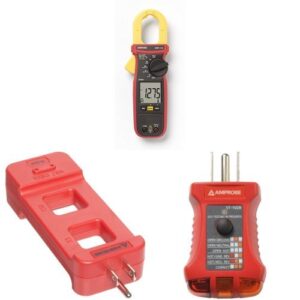
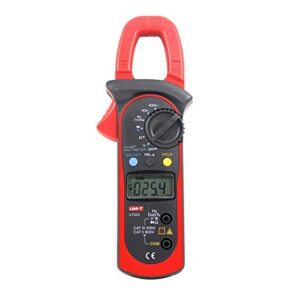
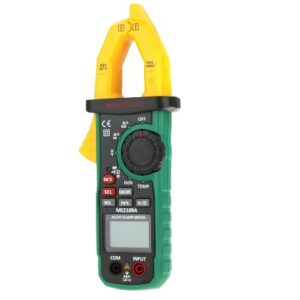
Customer’s Choice: the Best Rated Clamp Meters
[survey_answers id=”1848588779″ style=”plain” data=”score”] users answered this survey. Please help us improve this review!
[survey_answers id=”1848588779″ style=”piechart” legend=”true”]
Clamp meters offer a safe, effective way to test electric currents without stripping wires. Whether you are a homeowner or a professional electrician, you can use a clamp meter to troubleshoot and resolve electrical issues.
Etekcity Auto-Ranging Clamp Meter – Editor’s Pick
 Our first impression of the Etekcity clamp meter was that it was hefty and durable. The device comes in a handy carrying case and is prepacked with powerful batteries. The clamp claws open wide. You can test an electric current without stripping a wire or breaking a circuit.
Our first impression of the Etekcity clamp meter was that it was hefty and durable. The device comes in a handy carrying case and is prepacked with powerful batteries. The clamp claws open wide. You can test an electric current without stripping a wire or breaking a circuit.
We were pleased with the clamp’s auto-ranging function. What’s more, readouts were accurate every time. On top of that, the bright LCD screen made it easy to view the results. We were able to use the Etekcity to test both AC and DC voltages, continuity, resistance, and diode. As such, we highly recommend this tool to both professionals and amateurs working on electrical projects.
Pros
- Accurate voltage measurements
- Jaws open 26 millimeters
- Sleep mode after 5 minutes of inactivity
- 2-year warranty
- Lifetime of tech support
- Hold, max, and select functions
- LCD display
- Carrying bag included
Cons
- Low battery life
Uni-T Mini Clamp Meter – Top-Selling Mini Clamp Meter
 Do you want a clamp meter you can stash in your pocket? The Uni-T is a trusted clamp meter that they can wrap your hands around. It offers consistent AC and DC measurements. What’s more, it rates a current’s continuity and resistance. On top of that, it provides a accurate diode assessment.
Do you want a clamp meter you can stash in your pocket? The Uni-T is a trusted clamp meter that they can wrap your hands around. It offers consistent AC and DC measurements. What’s more, it rates a current’s continuity and resistance. On top of that, it provides a accurate diode assessment.
The continuity reading is complemented by an audible buzzer. On top of that, it has the potential to store multiple readings. Despite its small size, the Uni-T has a jaw capacity of 17 millimeters.
The Uni-T automatically shuts off after 15 minutes of inactivity. It also has a low-battery indicator that kicks in when it is putting out less than 2.5 volts. The device is powered by two AAA batteries. It has an easy-to-read LCD screen. While it can only measure up to 100 amps, we still consider it to be one of the most versatile clamp meters on the market.
Pros
- Small and portable
- AC and DC voltage measurements as high as 100 amps
- Lighted display
- Multiple modes (max, min, zero)
- Measures resistance
- Diode
Cons
- Limited current measurements
Fluke’s 323 Clamp Meter – Top Upgrade Option
 Are you looking to upgrade an obsolete electrical meter? The Fluke 323 has an impressive capacity to measure currents. This meter can register AC currents as high as 400 amps. It also offers AC and DC voltage measurements. On top of that, the Fluke provides dead-on resistance ratings. Its hold feature lets you recheck previous readings.
Are you looking to upgrade an obsolete electrical meter? The Fluke 323 has an impressive capacity to measure currents. This meter can register AC currents as high as 400 amps. It also offers AC and DC voltage measurements. On top of that, the Fluke provides dead-on resistance ratings. Its hold feature lets you recheck previous readings.
The Fluke has a durable shell. It can withstand plenty of abuse. Its soft-shelled case goes along way to protect the screen and buttons. The 223 also has incredible battery life. If you need a meter that can handle regular use, the Fluke 323 is a dependable option.
Pros
- True RMS conversions
- Measure AC current
- Measures AC and DC voltages as high as 600 volts
- 30-millimeter jaw opening
- Measures both linear and non-linear loads
- Conductivity sensor with buzzer
- Includes zip-up carry case
Cons
- No slots for probes
Klein Tools Clamp Meter – Most Durable Clamp Meter
 We cannot get over the fact that this brutish clamp meter can withstand a 6.6-foot fall. Of course, it offers detailed readouts too. The durable leads can be used to measure AC and DC voltages. On top of that, they hone in on a current’s resistance, frequency, diodes, capacitance, and more.
We cannot get over the fact that this brutish clamp meter can withstand a 6.6-foot fall. Of course, it offers detailed readouts too. The durable leads can be used to measure AC and DC voltages. On top of that, they hone in on a current’s resistance, frequency, diodes, capacitance, and more.
The clamp even features a low-impedance mode that can be used to identify stray voltages.
This clamp meter makes it easy to make repairs and improve the safety of electrical systems. It has an onboard low-battery indicator and an easy-access battery port. Its double insulation provides users with the utmost protection. A thermocouple probe even enables users to test the temperature of wires.
Pros
- RMS
- Leads measure AC and DC voltages
- Resistance
- Diode tests
- Low-impedance mode
- Can withstand a 6.6-foot drop
- Low-battery indicator
- Includes carry case
Cons
- Expensive
Fluke 324 True RMS Clamp Meter – Most Readable Display
 This tried-and-true meter is slim and durable. It fits in the palm of your hand. On top of that, it offers a backlit screen that is visible both indoors and outdoors. The Fluke 324 is an ergonomic electric measurement device.
This tried-and-true meter is slim and durable. It fits in the palm of your hand. On top of that, it offers a backlit screen that is visible both indoors and outdoors. The Fluke 324 is an ergonomic electric measurement device.
It offers AC measurements up to 400 amps. On top of that, the leads can be used to account for currents as high as 600 volts. The 324 also provides users with accurate resistance, capacitance, and temperature readings.
The meter offers a gaping 30-millimeter jaw. It folds up easily and can be stored in the provided zip-up carrying case. The Fluke 324’s high price makes it ideal for professional electricians. Of course, that’s not to say that homeowners would be disappointed by this awesome tool. This resilient handheld clamp meter can’t be beat.
Pros
- AC current measurements as high as 400 amps
- AC and DC voltages with a 60-volt limit
- Measures resistance, capacitance, and temperature
- 30-millimeter jaw opening
- Audible buzzer for continuity
- Small and portable
- Large backlit screen
- Advanced RMS technology
- Lead compartments and carrying case
Cons
- None
Aimo MS2108A Auto-Ranging Clamp Meter – Top AC/DC Current Measurement
 The Aimo auto-ranging clamp meter eliminates the need to turn a knob. Instead, it offers fast, accurate alternating and direct currents. The body is remarkably durable and resistant to wear. What’s more, the meter offers several accurate measurements, including resistance and diode reports.
The Aimo auto-ranging clamp meter eliminates the need to turn a knob. Instead, it offers fast, accurate alternating and direct currents. The body is remarkably durable and resistant to wear. What’s more, the meter offers several accurate measurements, including resistance and diode reports.
You can take this device into the field without having to worry about inferior knobs or buttons. On top of that, the Aimo has impressive battery life. While the instruction manual needs a little tweaking, it’s something we can look past. At just under $50, you’d be hard-pressed to find a more accurate budget-rate meter. The device comes with one lead and a canvas carrying bag.
Pros
- Measures alternating and direct currents
- Measures voltages
- Measures resistance, frequency, capacitance, duty, continuity, and diode
- High-resolution LCD display
- 750-volt AC measurement limit
- Over-range protection
- Hold function
Cons
- Poor instructions
Sperry Instruments DSA500A Digital Snap-Around Meter – Top Multi-Function Device for the Price
 We love that the Sperry Instruments clamp meter boasts five functions. On top of that, it automatically cycles through nine resistance ranges. The meter can measure currents as large as 400 amps. What’s more, it can register AC/DC currents up to 600 volts.
We love that the Sperry Instruments clamp meter boasts five functions. On top of that, it automatically cycles through nine resistance ranges. The meter can measure currents as large as 400 amps. What’s more, it can register AC/DC currents up to 600 volts.
The clamp is a digital snap-around device that hugs an electric voltage for more accurate results.
The Sperry Instruments device comes with two leads and a pair of AAA batteries. On top of that, the set includes a durable carrying case and comprehensive instructions. Whether you’re testing motor parts or home wiring, you’ll have no trouble using the DSA500A. It’s easy to read in all lighting conditions. Best of all, it’s remarkably accurate.
Pros
- Comes with two test leads and AAA batteries
- Five functions
- Measures AC current (400 amp limit)
- Measures alternating and direct voltages (600-volt limit)
- Ergonomic design
- Automatic shutoff feature
- Includes carrying case
Cons
- None
Amprobe Clamp Meter Bundle – Top-Selling Clamp Meter Bundle
 Why would you just purchase a clamp-on meter when you could get your hands on a variety of electrical testing tools? This package comes with a meter, line splitter, and socket tester.
Why would you just purchase a clamp-on meter when you could get your hands on a variety of electrical testing tools? This package comes with a meter, line splitter, and socket tester.
The clamp-on measuring system features is capable of commuting capacitance measurements.
It can register currents as 310 amps and voltages as high as 600 volts. The line splitter can wrap itself around both small- and large-diameter power cords. It has one- and ten-time loops for accurate measurements of high and low voltages. It is suitable for currents up to 120 volts and 15 amps. Finally, the socket tester allows you to test GFCI outlets with ease. The device enables you to identify substantial wiring in the press of a button. Like most Amprobe tools, it features UL and CSA certifications.
Overall, this package offers consumers the most bang for their buck. With an assortment of accurate tools, most homeowners and electricians can pull off dependable repairs. The Amprobe clamp meter bundle is exceptionally rugged. What’s more, it boasts a long-lasting battery and plenty of functions.
Pros
- True RMS
- Measures capacitance
- Compatible with two- and three-wire power cords
- Includes Amprobe meter, ELS2A line splitter, and ST-102B socket tester
- Registers up to 600 volts
- Measurements to nearest tenth of amp
- Trusted manufacturer
Cons
- Different measurement modes can be confusing
Digital Clamp Meter Uni-Trend UT203 – Most Long-Lasting Clamp Meter
 The Uni-Trend UT203 offers some of the most accurate measurements in its price range. What’s more, it measures the current and voltage of AC/DC currents. With a 28-millimeter jaw capacity, we struggled to get this device over some of our bulkier wires.
The Uni-Trend UT203 offers some of the most accurate measurements in its price range. What’s more, it measures the current and voltage of AC/DC currents. With a 28-millimeter jaw capacity, we struggled to get this device over some of our bulkier wires.
When it fit, which was most of the time, we were able to garner accurate AC/DC, resistance, temperature, diode, and continuity readings.
As a bonus, this device boasts several unique modes. First off, it’s an auto-ranging meter. It also has hold, sleep, and low-battery functions. On top of that, it is lightweight, durable, and compact. We’d chuck this beastly tool in the back of a truck without giving it a second thought. Of course, it also meets or exceeds all of our safety requirements.
Pros
- Measures alternating and direct currents up to 600 volts
- Measures alternating and direct voltages up to 400 amp
- Comes with two test leads
- Well-written user manual
- Measures frequency
- Overload protection
- Ergonomic and portable
Cons
- Budget-rate
Mastech MS2109A True RMS Digital AC/DC Clamp Meter – Best Clamp Meter Design
 We love the look and feel of this small yet mighty clamp meter. It has an attractive green body and a bright yellow jaw. The clamp can widen to about 26 millimeters. It can test AC/DC voltage and current. What’s more, it can churn out resistance, capacitance, frequency, and duty cycle results.
We love the look and feel of this small yet mighty clamp meter. It has an attractive green body and a bright yellow jaw. The clamp can widen to about 26 millimeters. It can test AC/DC voltage and current. What’s more, it can churn out resistance, capacitance, frequency, and duty cycle results.
The Mastech has a good-sized digital display with a bright backlight. It features a low-battery indicator as well as an automatic power-off mode. You can store several data sets for easier recalls and comparisons. The Mastech takes three AAA batteries. A temperature probe and two leads are included in the kit.
Pros
- Work light and back light
- Low battery indicator and automatic shutoff feature
- Hold and other data storage features
- Thermocouple temperature measurements
- Measures AC/DC voltage and current
- Measures resistance, capacitance, frequency, and duty cycle
- Non-contact voltage detector
Cons
- Lacks accuracy
Buyer’s Guide
What to Look For in a Clamp Meter
Accuracy
Your clamp meter must offer consistent and accurate measurements. A dependable clamp meter puts out identical measurements for a single current. You can rule out accuracy issues by opting for a model from a trusted brand.
Design
A clamp meter is a handheld device. As such, it should be portable, durable, and easy to use. We recommend opting for a meter with a glowing LCD screen and distinct controls. Ensure that the device is durable enough to withstand a few bumps and bruises. Always opt for a model that works well in both dim and bright conditions. You might be testing a wire in a vehicle or a crawlspace. Where ever your electrical work takes you, you want to be well-prepared.
Features
Some clamp meters offer an assortment of data tools, such as auto-ranging, holds, and sleep functions. Auto-ranging features enable users to receive automatic readouts. This is extremely helpful if you do not know the resistance range of the current you are testing. Instead of flipping through several settings, you can simply set your clamp meter to its auto-ranging setting. Data holds are also helpful. They enable you to store and compare measurements. A meter that can store more than one measurement is extremely desirable. Of course, auto-shutoff and sleep functions enable you to conserve battery power without making a conscious effort to do so.
Measurement Parameters
Most clamp meters provide you with a measurement of AC currents. However, some meters also offer AC/DC voltage readings. On top of that, some clamp meters provide continuity, resistance, capacitance, and diode measurements or reports. Continuity readings determine whether a current is complete and connected. Resistance measures how a electric current flows through a device. It is reported in ohms. Meanwhile, a diode is a device that keeps currents flowing in one direction. Detailed readings provide users with a more in-depth understanding of electric currents. This makes for safer, more accurate repairs.
The Clamp Meters FAQ:
What is the function of a clamp meter?
A clamp meter is an electrical test device. It includes the features of a standard digital multimeter and a power current sensor. It reminds the hard jaws consisting of ferrite iron that measures the magnetic field produced by current.
Its main functions are quite simple:
- It probes measure voltage and current. An electrician uses this device like the “jaws” around a cable or wire to measure the current without disconnecting the whole electrical system;
- Contemporary clamp meters provide more functions to measure electrical systems for greater accuracy;
A basic device includes all the functions of DMM (digital multimeter) – to measure resistance, voltage and continuity.
These measurement tools became popular for 2 reasons:
- Convenience. An electrician doesn’t need to cut off the whole circuit carrying current;
- Safety. Thanks to these tools, electricians do not have to cut into the wire and insert the testing device inside of it to measure the current;
The tool offers a huge leap in efficiency and safety for electric works.
The clamp meter design is also important. Visually, you can assess the quality of the materials used to create this device. The case and parts should not look flimsy or “disposable”. Poorly fitting parts, cracks, chips and other deformations should prevent you from the purchase. If you see any metal elements on the meter’s surface, it is also unacceptable.
What is the best clamp meter for an electrician?
Professional electricians tend to choose cost-effective and safe clamp meters with such options:
- Markings for minimum and maximum currents;
- The large size of the hard jaws;
- Capable of measuring AC/DC or only AC current;
- Auto-ranging option;
- Dial or thumbwheel for checking the options;
- Accuracy;
- LCD display with a high resolution and additional backlight;
- Safe use and installation;
According to the user feedback, the most popular clamp meters are manufactured by the brands – Fluke, Fieldpiece, Klein Tools, IDEAL.
Which is better for using – a digital multimeter or clamp meter?
Since a clamp meter contains the features of a digital device called multimeter, many people think these devices are the same tools. But, in fact, there are a few differences to learn about. Let’s compare the major functions of both measurement tools:
1) A clamp meter
These test devices are great for non-contact measurement. This instrument clenches like the jaws around a wire to measure the rate of amperage. These tools are precise, safe to use, efficient, and very simple.
Major functions:
- Measure the current rates without turning off the power circuit;
- Perfect for fixing the problems with current;
- Can do the measuring with multiple purposes – e.g. the device speed and the power current are measured at the same time;
- Decreased accuracy rates and the worse resolution compared to multimeters;
- It can be harder to open the jaws in some situations;
2) A multimeter
A multimeter is used to test current in series within the circuit. The circuit must be broken to let current flow through the device.
Major functions:
- Measurement of resistance, voltage, frequency, continuity to different levels of accuracy;
- It can value the systems with a higher LCD resolution;
- Great for electricians;
- Good only for measuring the low or medium power circuit;
Basically a clamp meter device is used to measure amperage with the best accuracy. While a multimeter is used to measure resistance, continuity and voltage. Electricians use both devices for the most accurate measurements.
To see the minute changes of the current in microamps, milliohms and millivolts, electricians use a DMM tool. The tool can measure the 10th or 100th of a unit, as opposed to thousandths and millionths.
How accurate are clamp meters?
Accuracy is the most important feature when it comes to selecting this particular instrument. The error with accuracy is not acceptable. The greater accuracy, the better indication of how close the rate is displayed on the display of the instrument. Electricians need to know the actual measurement of the power current.
How to check the accuracy level? Percent of reading is what you should look for. For example, if the device shows the accuracy of 1% on the reading, you should interpret it as 100 amps. While the actual rate varies around 101 amps.
Some devices include more specifications for great accuracy levels.
What is the best clamp meter for HVAC?
HVAC engineers need a really powerful tool that can measure the current of 460 VAC. For instance, you may choose the Flukes HVAC specific device for measuring VAC, VDC, Ohms, micro-amps (to measure flame sensors), temperature, capacitance, and Amps. Also, the device must be convenient to use when an engineer climbs ladders.
What is a clamp meter good for?
These devices are irreplaceable tools for electricians because they provide in-depth measurement values.
The major advantages:
- Different measurements (AC/DC voltage, temperature, resistance, etc.) without the use of auxiliary devices;
- Many additional features (retention of readings, automatic selection of measurement limits, backlight);
- Compact and lightweight tools;
- Easy to use;
Easy integration with other electrical measuring devices is another important function to look for. For example, AC/DC devices combined with a multimeter make an effective combo.
In general, the best instruments are very affordable tools to measure the voltage of an electrical current. They are contemporary digital devices with clear LCD displays and they are safer to use if compared with basic multimeters.
The tools are required for quick and non-contact measurement of AC and DC current in conductors. However, modern devices can also cope with a few different tasks such as measuring the level of insulation resistance, frequency, voltage, diodes, temperature, etc.
The best thing – the circuit does not have to be interrupted during measurements, the current in the conductor does not break and remains isolated from the inputs.
Some manufacturers add a locking button that allows saving the measured values on the display.
Before you buy this kind of testing device, you need to think about the use of them. If you are not an electrician, then you may skip too accurate instruments with multiple features.
You can choose a budget-friendly device with the most basic functions:
- Measurement of AC/DC current;
- Measurement of AC and DC voltage;
- Power consumption;
- Thermometer;
- Resistance;
Can we measure DC current with a clamp meter?
When electricians need to use the high levels of DC voltage, they tend to select these devices over multimeters. DMMs can’t measure 10 A currents longer than 30 secs. The tools can measure the current range from 0 A to 100 A. Some models can measure up to 1400 A.
These tools are used when you want to value the current of industrial controls and equipment, commercial or industrial HVAC. Most devices measure in such a way:
- AC/DC current parameters are measured in A (ampere). The current generates the heat feature and magnetic fields – these rates are required to repair inductors, motors and generators;
- AC/DC voltage rates are measured in V (volts). These digital devices can measure the difference value in the electrical potential. In other words, they show how much electric power is delivered when the circuit transports the electrons;
Can you measure the voltage with a clamp meter?
One of the basic features is to check voltage, AC or DC or AC/DC at the same time. To get voltage with an AC/DC device you should follow such steps:
- Select between Volts AC or Volts DC on the display;
- Install the probe for black testing into the COM jack;
- Then do the same with the red test probe – place it in the V jack;
- Across a power circuit source, touch the tips of probes to the circuit;
- Check the readings showed on the display;
Sometimes you should also push the HOLD button to stop the reading of the LCD. Then the meter must be removed from the live current.
Important notice: The frequency of the signal can affect the tool’s ability to measure AC voltage. Basic devices can value AC voltage with the frequency range up to 500 Hz. If you need to measure higher frequency, pick a multimeter device with the AC bandwidth from 100 kHz. That is why these tools show different voltage readings of the same electrical current.
How does DC clamp meter work?
AC devices work on the principle of CT (current transformer) to measure the magnetic flux generated by the current flow through a conductor. DC and AC currents are measured in the same way.
To measure DC current a DC or AC/DC gadget is not even connected to the wire directly. The wire goes inside the clamp before you even turn on the device.
To measure direct current with this instrument, the device should have the Hall effect’s sensor. This sensor responds to magnetic flux by increasing the magnitude of the voltage across the element. The magnitude of the voltage is proportional to the magnitude of the magnetic flux and the magnitude of the current in the conductor, respectively.
Thanks to the use of a digital converter, a DC meter accurately converts the readings of the Hall effect’s sensor and measures the value of the direct current in the conductor.
The number of Hall effect’s sensors will vary from one device to another. Inexpensive devices have only one sensor. Professional models are equipped with two sensors.
Video Tutorial: How To Use a Clamp Meter
[embedyt]https://www.youtube.com/watch?v=Bc_EQea0mKY[/embedyt]Final Thoughts
We hope you enjoyed our roundup of the top-ten clamp meters. These incredible devices enable you to map out electrical connections without performing invasive procedures. Keep in mind that you need to have a sound understanding of electrical metrics to put these instruments to good use.
These most user-friendly machines on our list were recommended by professional electricians. Before you opt for the most technical and complicated clamp meter, look for one that provides accurate and reliable metrics. On top of that, find one that’s durable and easy to carry. With that, you’ll be set for a lifetime of electrical tests!

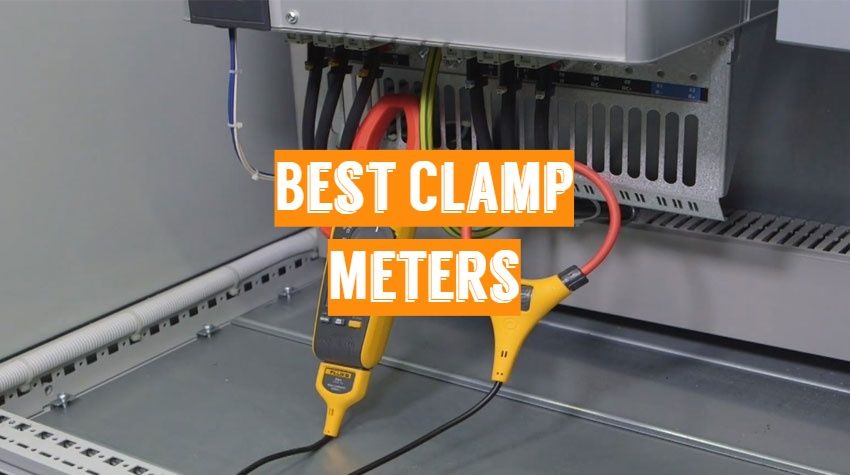

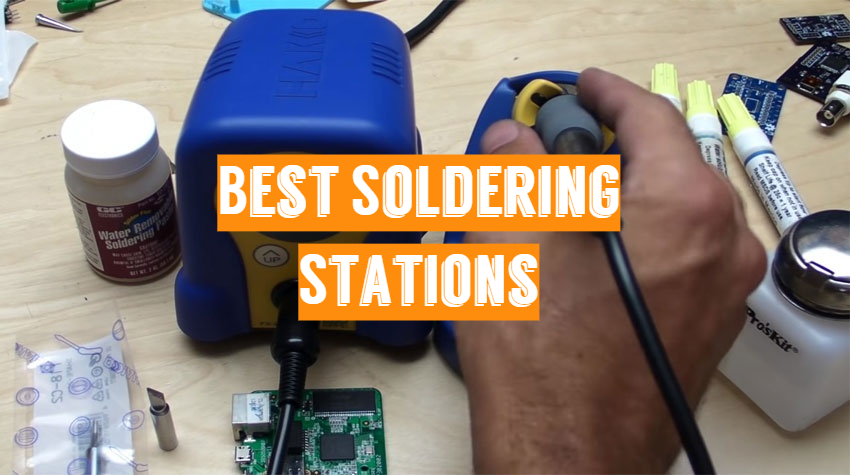
This is a really useful tutorial on how to use a clamp meter. Everyone, including hobbyists, can benefit from having one handy for projects when the needs arises. Using it properly took me a bit to figure out, so I wish I had found this video sooner! Thanks for sharing.
Thanks for this buying. I need to invest in a clamp meter to add to my workstation. Any of these would be useful for my basic needs. The video here on how to use it properly is particularly helpful. I am going to bookmark it for future reference during an upcoming project.
Hello, thanks for your comment!
Clamp meters are an essential product to have if you are ever working with electricity. Who would want to spend hours working on a project or home repair only to find out that it doesn’t work…? Clamp meters solve this problem and will always let you know when there is a current going through the wire.
Hello, Pete! Thanks for your comment.
The Uni-T is a great clamp meter. It’s very small so you can take it with you, in your pocket and provide an accurate diode assessment. It also rates a current’s continuity and resistance. The Uni-T mini clamp meter sells like hotcakes for a reason: it’s very good. It also is very affordable, portable and does a lot of things right, just like a regular sized clamp meter. The Etekcity clamp meter seems to be its bigger brother and is perfect for people who want more power.
Pretty nice that the Fluke 323 clamp meter can measure AC and DC voltages up to 600 volts!
MASTECH MS2109A – I’ve had this meter for approx 3 years of light use. I loved the size, form-factor, and especially being able to measure DC current with the clamp-on-loop. But this year… it’s become unreliable. There’s sometimes up to +/- 1A error when measuring current under 10A, the DC voltage is flaky, wobbly or just off by a volt or more at low volts, the resistance says ~180 ohms then starts counting down when the probes are shorted. Continuity beep no longer works. I’ve tested probes and cleaned the rotary switch… no joy. There’s possibly something fixable… but a test instrument shuldn’t be that unreliable after 3 years. i have auto-parts store meters that have lasted longer.